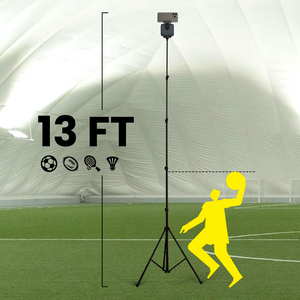XbotGo Chameleon AI Sports Camera
Basketball Stat Sheet Abbreviations Guide
Whether you're a returning fan after years away from the game, a parent trying to follow your child's team, or a coach looking to better understand modern analytics, basketball stat sheets can feel like reading a foreign language. Those seemingly endless combinations of letters and numbers tell the complete story of what happens on the court—if you know how to decode them.
Why Basketball Statistics Matter More Than Ever
Basketball has evolved dramatically over the past two decades. The game that once relied on simple box scores now generates mountains of data that can reveal hidden patterns, player effectiveness, and team strategies. Understanding these statistics isn't just for analysts anymore—it's become essential for anyone who wants to truly appreciate what's happening during a game.
Modern basketball statistics serve multiple purposes. They help coaches make strategic decisions, allow players to identify areas for improvement, and give fans deeper insights into the game they love. Whether you're analyzing your high school team's performance or following your favorite NBA squad, knowing what these abbreviations mean transforms random numbers into meaningful stories.
The Foundation: Essential Basic Statistics
Let's start with the fundamental statistics that form the backbone of every basketball stat sheet. These are the numbers you'll see in every box score, from youth leagues to the NBA.
PTS (Points) represents the total number of points a player or team scores. This includes all field goals (2-pointers and 3-pointers) and free throws. While it's the most straightforward stat, points alone don't tell the whole story of a player's contribution.
FG (Field Goals Made) and FGA (Field Goals Attempted) track successful baskets and shot attempts, excluding free throws. The relationship between these two numbers gives us FG% (Field Goal Percentage), calculated by dividing field goals made by field goals attempted. A player shooting 50% or better is generally considered efficient.
REB (Rebounds) measures how many times a player retrieves the ball after a missed shot. This breaks down into OREB (Offensive Rebounds) when you grab your own team's miss, and DREB (Defensive Rebounds) when you secure the opponent's miss. The combined total gives you TRB or REB (Total Rebounds).
AST (Assists) counts the passes that directly lead to a made basket. This stat highlights playmaking ability and teamwork. Point guards typically lead in this category, though modern basketball sees assists distributed across all positions.
STL (Steals) tracks how many times a player takes the ball away from the opponent, while BLK (Blocks) counts rejected shot attempts. Both represent crucial defensive plays that can shift momentum.
TO or TOV (Turnovers) shows how many times a player or team loses possession through errors like bad passes, travels, or offensive fouls. Lower numbers indicate better ball security.
PF (Personal Fouls) tallies the infractions committed by a player. In most leagues, accumulating too many fouls results in disqualification from the game.
Shooting Statistics: Beyond Basic Percentages
Understanding shooting efficiency requires looking beyond simple field goal percentage. Modern basketball has developed more nuanced ways to evaluate shooting performance.
3P (3-Point Field Goals Made) and 3PA (3-Point Field Goals Attempted) specifically track long-range shooting. The resulting 3P% (3-Point Field Goal Percentage) has become increasingly important as teams attempt more three-pointers than ever before. League average typically hovers around 35-36%.
2P (2-Point Field Goals Made) and 2PA (2-Point Field Goals Attempted) separate shots inside the arc. The 2P% (2-Point Field Goal Percentage) usually runs higher than three-point percentage, often above 50% for efficient players.
FT (Free Throws Made) and FTA (Free Throws Attempted) measure performance from the charity stripe, with FT% (Free Throw Percentage) showing consistency under pressure. Elite free throw shooters maintain percentages above 85%.
Two advanced shooting metrics deserve special attention. eFG% (Effective Field Goal Percentage) adjusts for the added value of three-pointers using the formula: (FG + 0.5 × 3P) / FGA. This gives a more accurate picture of scoring efficiency by weighing three-pointers appropriately.
TS% (True Shooting Percentage) goes even further by incorporating free throws: Points / (2 × (FGA + 0.44 × FTA)). This comprehensive metric best captures overall scoring efficiency, with elite scorers often exceeding 60%.
Advanced Analytics Made Simple
While advanced statistics might seem intimidating, they're simply tools to better understand player impact beyond traditional counting stats.
PER (Player Efficiency Rating) attempts to summarize a player's statistical accomplishments in a single number. League average is always 15.0, with stars typically rating above 20 and superstars exceeding 25. While useful, PER favors high-volume players and should be considered alongside other metrics.
USG% (Usage Percentage) estimates the percentage of team plays used by a player while on the floor. This includes shot attempts, turnovers, and trips to the free-throw line. Star players often have usage rates above 30%, while role players typically fall between 15-20%.
+/- (Plus-Minus) tracks the point differential when a player is on the court. If your team outscores opponents by 10 points during your 20 minutes of play, your +/- is +10. This stat requires context, as it's heavily influenced by teammates and opponents.
PIE (Player Impact Estimate) measures the percentage of game events a player contributes to while on the floor. Unlike some advanced stats, PIE is easy to understand—a PIE of 10% means a player was responsible for 10% of the positive things that happened during their time on court.
Win Shares estimate the number of wins contributed by a player, combining offensive and defensive impact. OWS (Offensive Win Shares) and DWS (Defensive Win Shares) can be examined separately to understand where a player's value comes from.
Team Statistics vs Individual Statistics
Basketball stat sheets typically separate team totals from individual performances, each telling different parts of the story.
Team statistics aggregate everyone's contributions and include unique measurements like PACE (possessions per 48 minutes), which indicates playing speed. Fast-paced teams might average 100+ possessions, while deliberate teams stay in the 90s.
OffRtg (Offensive Rating) and DefRtg (Defensive Rating) measure points scored and allowed per 100 possessions, respectively. The difference between these creates NetRtg (Net Rating), with positive numbers indicating winning basketball.
Individual statistics within team contexts gain additional meaning. A player's rebounding numbers matter more on a team that struggles on the boards. Similarly, assist totals vary significantly between motion offenses and isolation-heavy systems.
Understanding percentage-based team stats helps evaluate individual contributions. AST% (Assist Percentage) shows what percentage of teammate field goals a player assisted. REB% (Rebound Percentage) indicates the percentage of available rebounds grabbed. These context-dependent stats better reflect impact than raw totals.
Platform Variations and Solutions
One frustrating aspect of following basketball statistics is the inconsistency across platforms. The NBA's official site might use different abbreviations than ESPN or Basketball-Reference, creating confusion for fans trying to compare data.
Common variations include MIN vs MP (Minutes Played), TO vs TOV (Turnovers), and 3P vs 3PM (3-Pointers Made). Some sites use FGM for field goals made, while others simply use FG. International leagues might use entirely different terminology.
The solution? Focus on understanding concepts rather than memorizing platform-specific abbreviations. Whether a site uses TO or TOV, you're looking at turnovers. When you understand what each statistic measures, minor labeling differences become less confusing.
Creating your own reference sheet for frequently-used platforms can help. Note the specific abbreviations used by sites you visit regularly, but remember that the underlying statistics remain consistent regardless of labeling.
Reading Stats in Real Game Context
Statistics gain meaning when connected to actual game situations. Let's explore how to interpret numbers while watching or analyzing games.
During live games, focus on shooting percentages and turnover rates to gauge team performance. A team shooting below 40% while committing 15+ turnovers faces an uphill battle. Conversely, maintaining 50%+ shooting with single-digit turnovers usually indicates good execution.
For individual players, examine shot distribution alongside percentages. A guard taking mostly three-pointers needs lower overall FG% to remain efficient compared to a center shooting primarily at the rim. Context determines whether 45% shooting represents good or poor performance.
Defensive statistics require particular attention to context. Low opponent shooting percentages might reflect excellent defense or simply poor shooting. Watching games reveals whether contests, rotations, and schemes drive the numbers or if opponents are missing open looks.
Fourth-quarter statistics often reveal clutch performers. Players maintaining or improving their efficiency in crucial moments demonstrate mental toughness. Compare fourth-quarter numbers to overall averages to identify who steps up when games hang in the balance.
Using Statistics for Better Basketball Understanding
Statistics serve different purposes for different basketball community members. Coaches use them to identify strengths and weaknesses, plan strategies, and make rotation decisions. Parents can better appreciate their children's contributions beyond scoring. Fans gain deeper enjoyment through understanding the nuances that numbers reveal.
For coaches, combining traditional and advanced stats creates comprehensive player evaluations. High-scoring players with poor shooting percentages might need shot selection work. Strong rebounders with low defensive ratings might lack awareness or positioning. Statistics guide development priorities.
Parents new to basketball can start with basic counting stats before progressing to percentages and advanced metrics. Understanding that assists matter as much as points, or that defensive rebounds prevent second chances, helps appreciate complete games rather than just scoring.
Fans benefit from statistics that reveal hidden contributions. The player setting screens for shooters might show low traditional numbers but high teammate shooting percentages. The defender forcing difficult shots might not accumulate many steals or blocks but significantly impacts winning.
The Evolution Continues
Basketball statistics continue evolving with technology. Tracking data now measures distance traveled, speed, and defensive impact in ways traditional stats never could. As these metrics become more accessible, our understanding of the game deepens further.
Today's youth players grow up with statistical awareness previous generations lacked. They understand efficiency, shot selection, and comprehensive impact from early ages. This statistical literacy creates more intelligent players and engaged fans.
For those feeling overwhelmed by basketball's statistical revolution, remember that every advanced metric stems from basic concepts. Master the fundamentals—points, rebounds, assists, shooting percentages—before tackling complex formulas. Build understanding gradually, connecting numbers to game actions you observe.
Modern technology makes tracking these statistics easier than ever. AI-powered cameras can automatically capture every stat mentioned in this guide, transforming what once required dedicated statisticians into accessible data for any team. This democratization of analytics means coaches at all levels can leverage professional-grade insights to develop players and strategies.
Your Statistical Journey Starts Now
Basketball's statistical language might seem complex initially, but fluency comes with practice. Soon, you'll scan stat sheets as easily as reading game recaps, extracting meaningful insights that enhance your basketball experience. The numbers that once confused now illuminate, revealing basketball's beautiful complexity through elegant mathematical expression.
XbotGo Chameleon AI Sports Camera
Capture every moment with AI-powered tracking. Perfect for coaches, parents, and athletes who want seamless footage without manual filming.







 Soccer
Soccer Basketball
Basketball Ice Hockey
Ice Hockey Rugby
Rugby

























